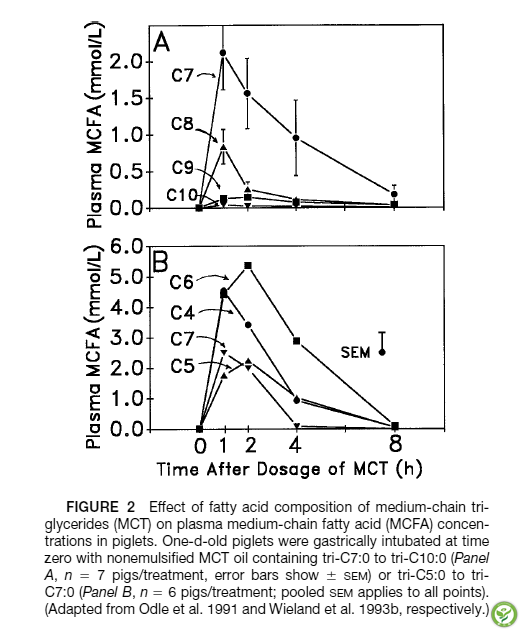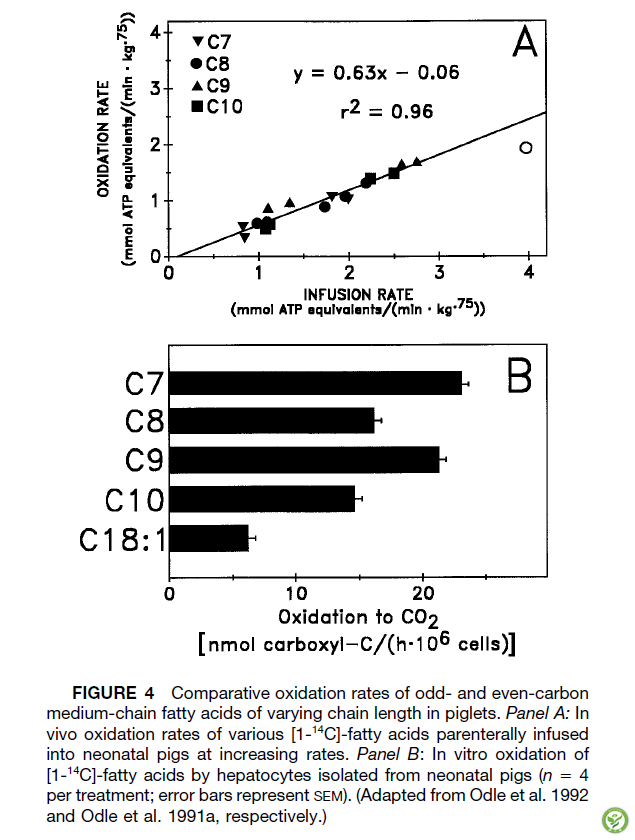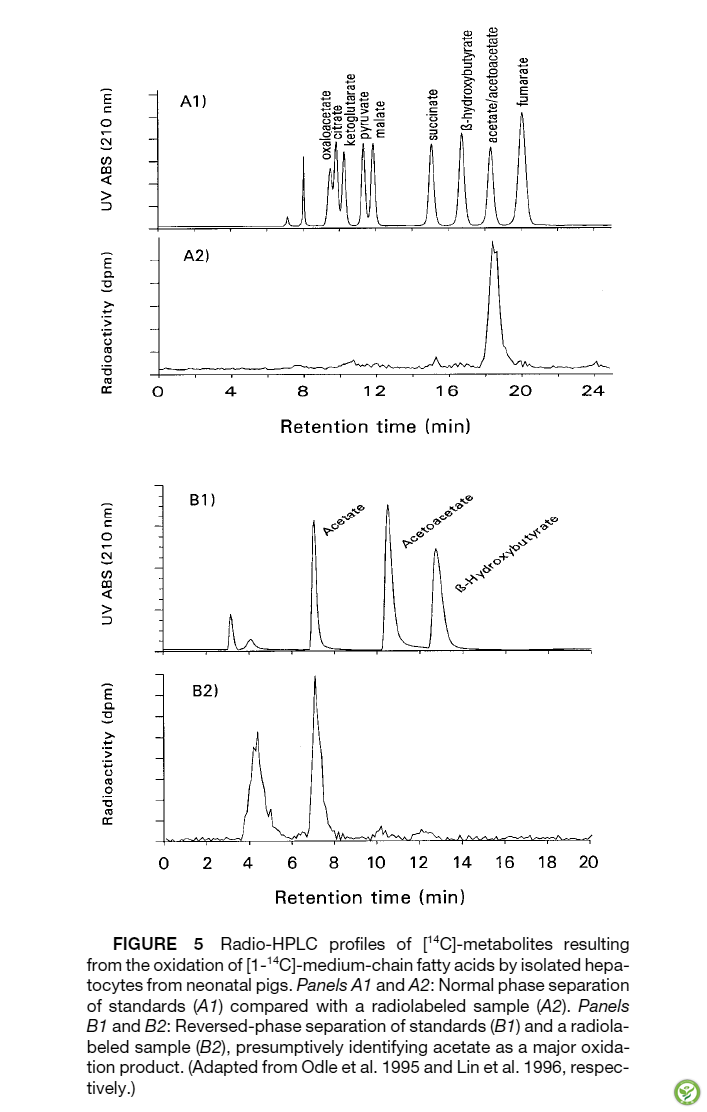New Insights into the Utilization of Medium-Chain Triglycerides by the Neonate: Observations from a Piglet Model
作者:Jack Odle
Department of Animal Science, North Carolina State University, Raleigh, NC 27695
来源:J. Nutr. 127: 1061–1067, 1997.
翻译:肠动力研究院 梁琦
【摘要】由于有着独特的消化和代谢特性,中链甘油三酯(MCT)被用于各种营养制剂,包括用作新生幼畜易消化的能量来源。本综述总结了本实验室从新生仔猪模型中得出的与MCT消化和代谢有关最新的一些研究发现,可能与人类婴儿有着临床相关性。研究结果显示:随着仔猪出生时间的延长(24小时内),MCT利用率迅速提高,这可能与胰脂肪酶的激活有关。其他数据则表明:乳化和脂肪酸链长度(中链同系物)对仔猪利用率的影响显著,并且三酰基己酸酯的利用率最高。同样,这些效应可通过消化动力学而非代谢的增加而介导。实际上,使用体外和体内放射性示踪剂技术时无法检测偶数链脂肪酸同系物之间的代谢差异。然而,研究表明:与偶数链脂肪酸同系物相比,孤立性肝细胞对奇数链脂肪酸氧化率更高,部分原因是奇数碳脂肪酸氧化产生的丙酰辅酶A具有回补反应。而体内放射性示踪剂的研究显示:随着辛酸氧化产物CO2浓度的升高,不喂食初乳而补充左旋肉碱的仔猪尿中二羧酸排泄量随之减少。新的代谢研究发现:仔猪肝脏合成酮体的能力非常有限,并且乙酸盐可能是肝脏中脂肪酸氧化的重要产物。
【关键词】中链甘油三脂;脂肪酸代谢;左旋肉碱;猪
以下是实验中的相关图表
图1:中链和长链甘油三酯和脂肪酸通过肠道,肝脏和脂肪组织代谢。图中定义了缩写。与LCT相比,MCT能够被很快消化;与LCFA相比,MCFA通过门静脉循环能够被迅速地吸收而LCFA重新酯化并形成乳糜微粒被淋巴系统吸收。此外,MCFA主要被氧化,而LCFA直接沉积在甘油三酯中储存(1969年改编自Greenberger和Skillman。)

图2:中链甘油三酯(MCT)的脂肪酸组成对仔猪血浆中链脂肪酸(MCFA)浓度的影响。将1日龄仔猪用含有C7至C10((图A,处理n = 7头猪,误差线表示SEM)或C5至C7(B组,每组处理6头猪;SEM适用于所有点)的非乳化MCT油进行胃内插管并开始计时。

图3:乳化和脂肪酸链长度影响1日龄仔猪对中链甘油三酯的利用。图A:以未乳化形式或以30%(v / v)水包油乳剂的14C标记的C6或C8甘油三脂喂食仔猪(0时)(处理4头仔猪;SEM适用于所有点)。图B:饲喂使用各种乳化剂制备的中链甘油三酯乳剂1小时后,小猪血浆中的C8:0和C10:0浓度(每次处理4只)。浓度以喂食未乳化甘油三酯的小猪中观察的百分比表示,误差线表示SEM。(改编自Odle等,1994年或Wieland等,1993a)

图4:比较仔猪对不同链长的奇数和偶数碳的中链脂肪酸的氧化率。图A:肠外的14C标记的不同类型的脂肪酸以一种非常快的速率注入到仔猪的体内氧化速率。图B:从新生猪分离的肝细胞对14C标记的脂肪酸的体外氧化速率(每次处理4只,误差线以SEM表示)(改编自Odle等人,1992和Odle等人,1991a)

图5:新生仔猪分离的肝细胞中[1-14C]-中链脂肪酸的氧化产生[14C]代谢物的放射性-HPLC谱。图A1和A2:与放射性标记样品(A2)相比,标准物(A1)的正常分离相。图B1和B2:标准品(B1)和放射性标记样品(B2)的反分离相,假定乙酸酯为主要氧化产物(改编自Odle等人, 1995和Lin等人,1996年)

图6:数据表明左旋肉碱注入后对14C标记的辛酸氧化为CO2的影响(图A)和未吃初乳的仔猪肠外灌输辛酸16小时尿中二羧酸排泄的速率(图B)(改编自Kempen和Odle,1995)

启示
总之,中链甘油三酯具有许多独特的营养和代谢特征,可用于各种临床营养制剂。该综述总结了本实验室研究的重点:利用新生仔猪模型进一步评估新生幼畜的MCT和MCFA代谢。研究结果表明:在MCFA同系物中,仔猪对己酸(C6:0)的利用效果可能最好,应该进一步探索奇数链MCFA作为能量补充剂的可能性,左旋肉碱可能证明对MCFA代谢有益并且不应该忽略有着潜在毒性的MCT。尽管仔猪具有与人类相似的消化和代谢过程,但是据此得出不同物种间的具有类似的作用的推断要慎重。
Abstract
Because of their unique digestive and metabolic properties, medium-chain triglycerides (MCT) are used in a variety of nutritional settings, including use as a readily digestible energy source for the neonate. This review examines recent findings from our laboratory related to MCT digestion and metabolism that are drawn from a neonatal piglet model, but which may be clinically relevant to human infants. We have shown that MCT utilization improves rapidly with postnatal age (within 24 h), which is likely due to the ontogeny of pancreatic lipase. Additional data delineate the dramatic effects of emulsification and fatty acid chain length (within the medium-chain family) on utilization, with the suggestion that triacylhexanoate is utilized at the highest rate. Again, these effects are likely mediated via an increase in the kinetics of digestion rather than metabolism. Indeed, using both in vitro and in vivo radiotracer techniques, we were unable to detect metabolic differences among evenchain fatty acid homologues. However, studies with isolated hepatocytes have shown greater oxidation rates of odd-chain fatty acids compared with even-chain homologues, in part as a reult of the anaplerotic potential of propionyl-CoA arising from odd-carbon fatty acid oxidation. In vivo radiotracer studies also showed an improvement in octanoate oxidation to CO2, with a concomitant reduction in urinary dicarboxylic acid excretion when colostrum-deprived piglets were supplemented with L-carnitine. Further metabolic research led to the novel finding that piglets have a very limited hepatic capacity to synthesize ketone bodies, and that acetate may be a relatively important product of hepatic fatty acid oxidation in this species.
KEY WORDS: medium-chain;triglyceride fatty acid;metabolism carnitine;swine
Conclusion
In conclusion, medium-chain triglycerides possess many unique nutritional and metabolic characteristics that are useful in a variety of clinical nutrition settings. This review has presented
a focused summary of research from our laboratory which has utilized the neonatal piglet model to further examine MCT and MCFA metabolism by the neonate. Our findings suggest that among the MCFA homologues, hexanoate (C6:0) may be preferentially utilized, that odd-chain MCFA should be further explored as a supplemental fuel, that L-carnitine may prove beneficial for MCFA metabolism, and that the potential toxicity of MCT should not be ignored.Although the piglet possesses many digestive and metabolic similarities to humans (Moughan et al. 1992, Reeds and Odle 1996), the extrapolation of findings across species with known idiosyncra- sies (such as the deficit of ketogenesis in piglets) should be made with caution.
如您需原文,请联系本文作者和出版方,或请垂询肠动力研究院。本网站发布的所有资料将尽最大可能注明出处、作者及日期,如无意中侵犯了您的知识产权,请来信及时告知,我们将立即予以删除。
All information released by the WeChat Official Account will do its best to indicate the source, author and date. If we inadvertently infringe on your intellectual property, please inform us in time and we will delete it immediately.





